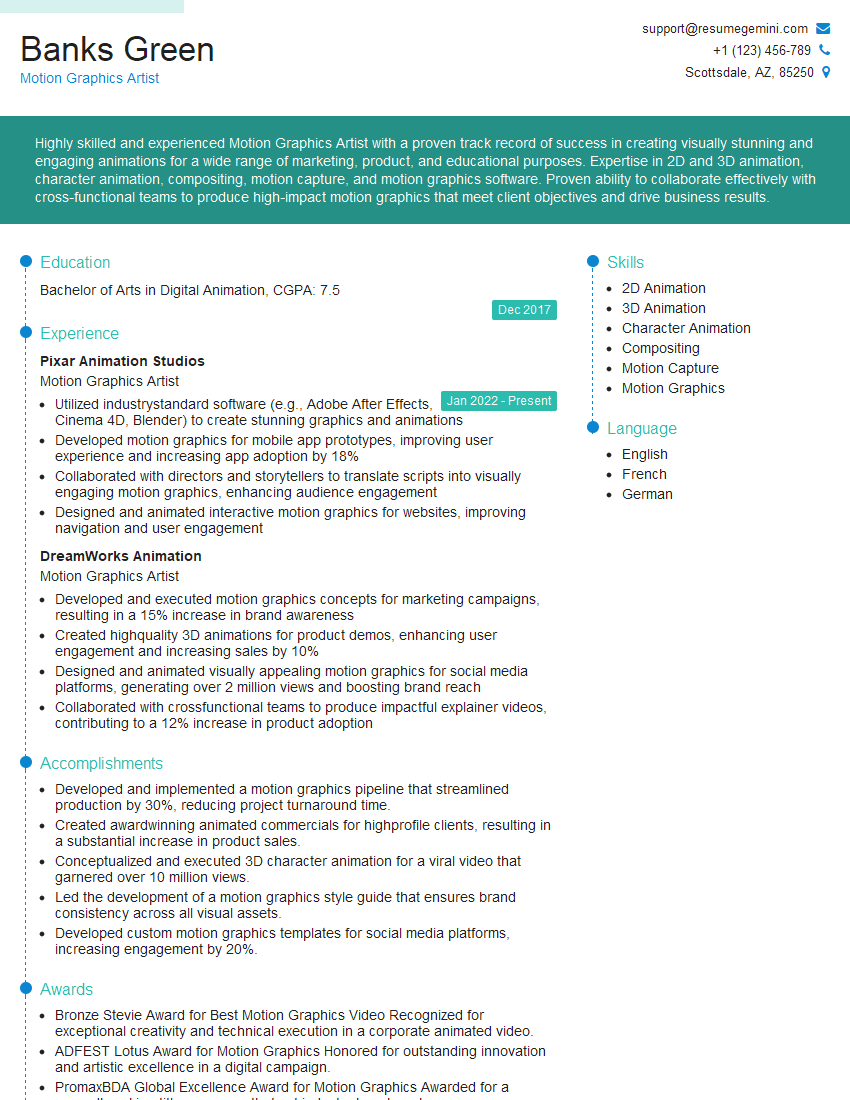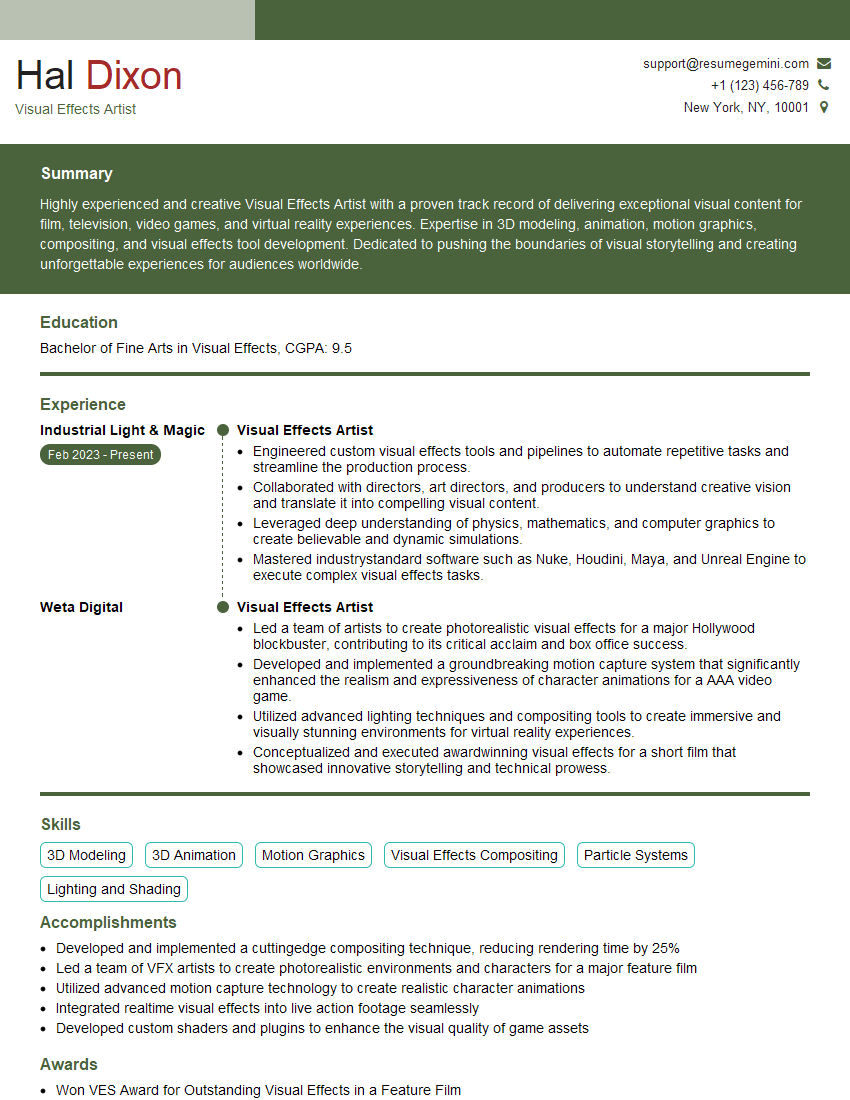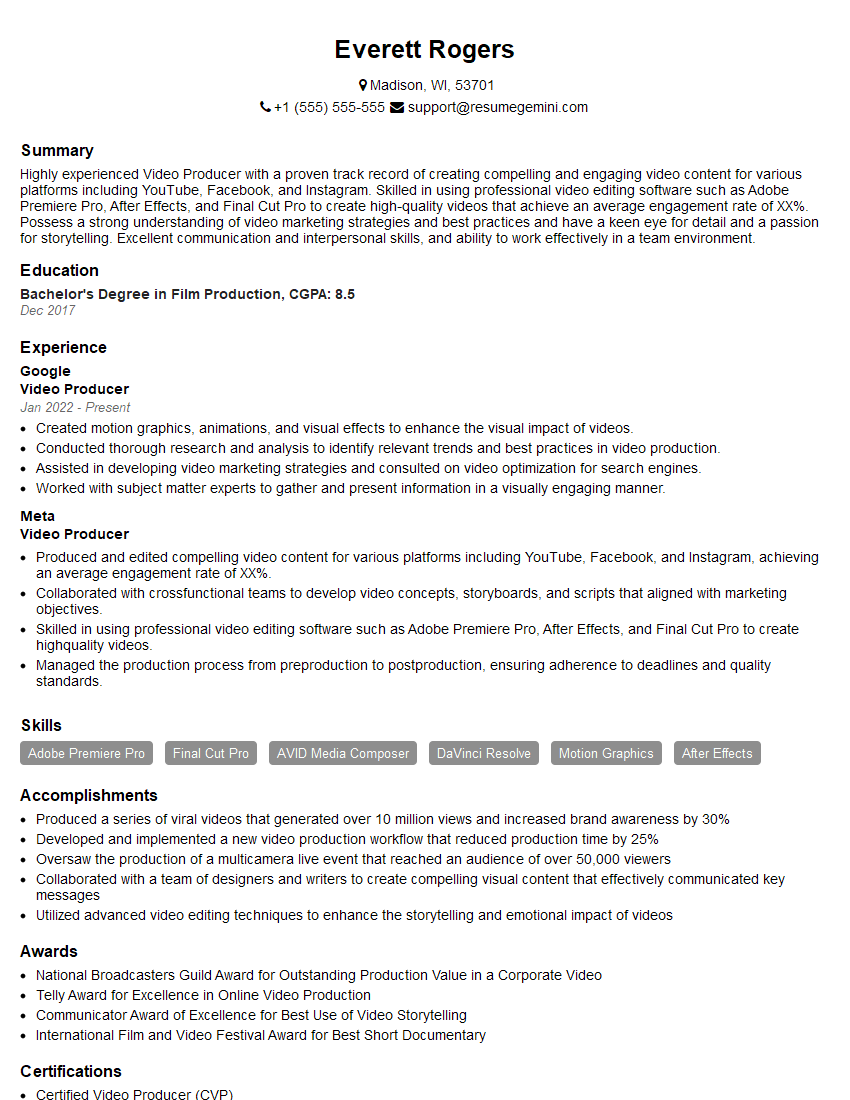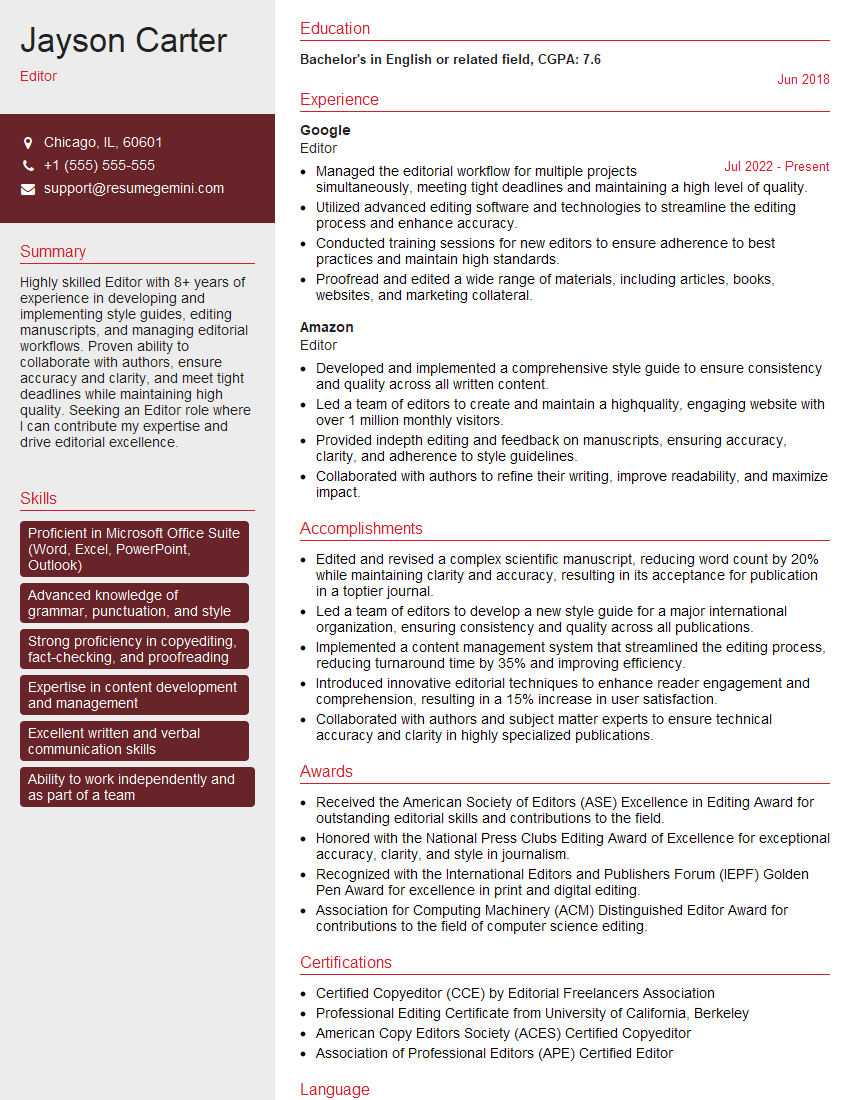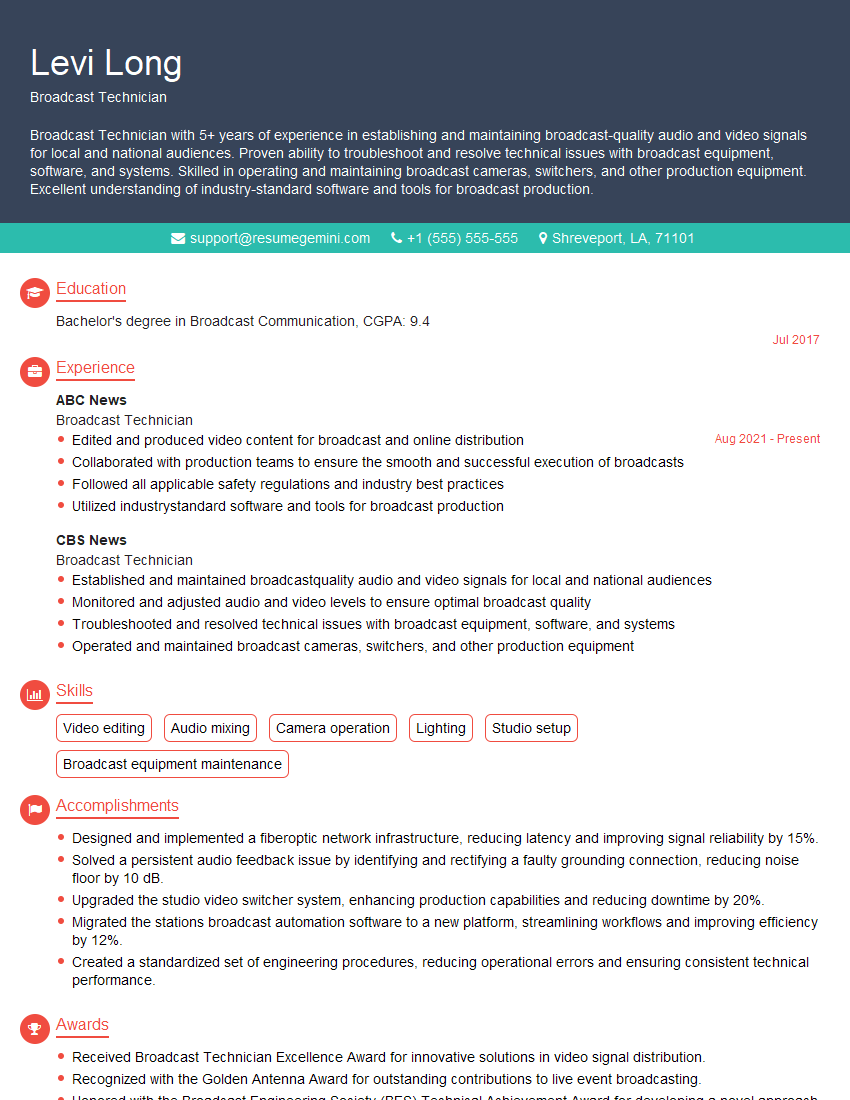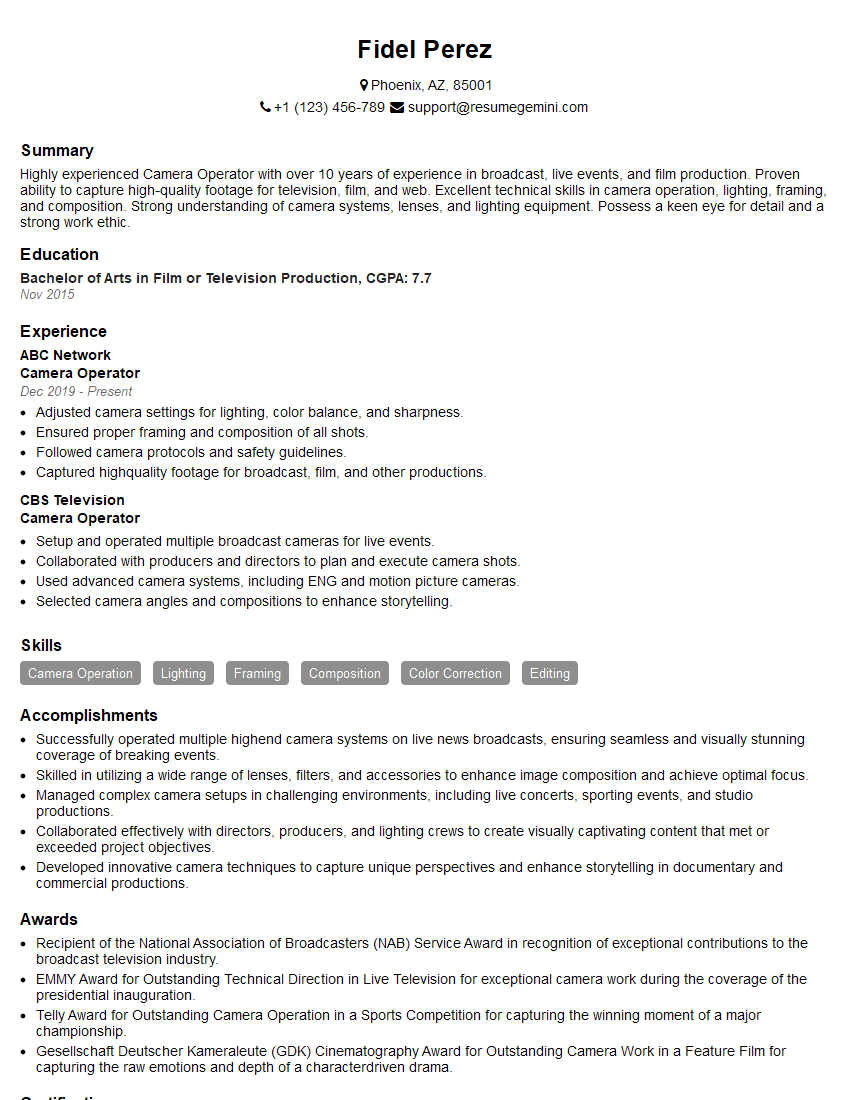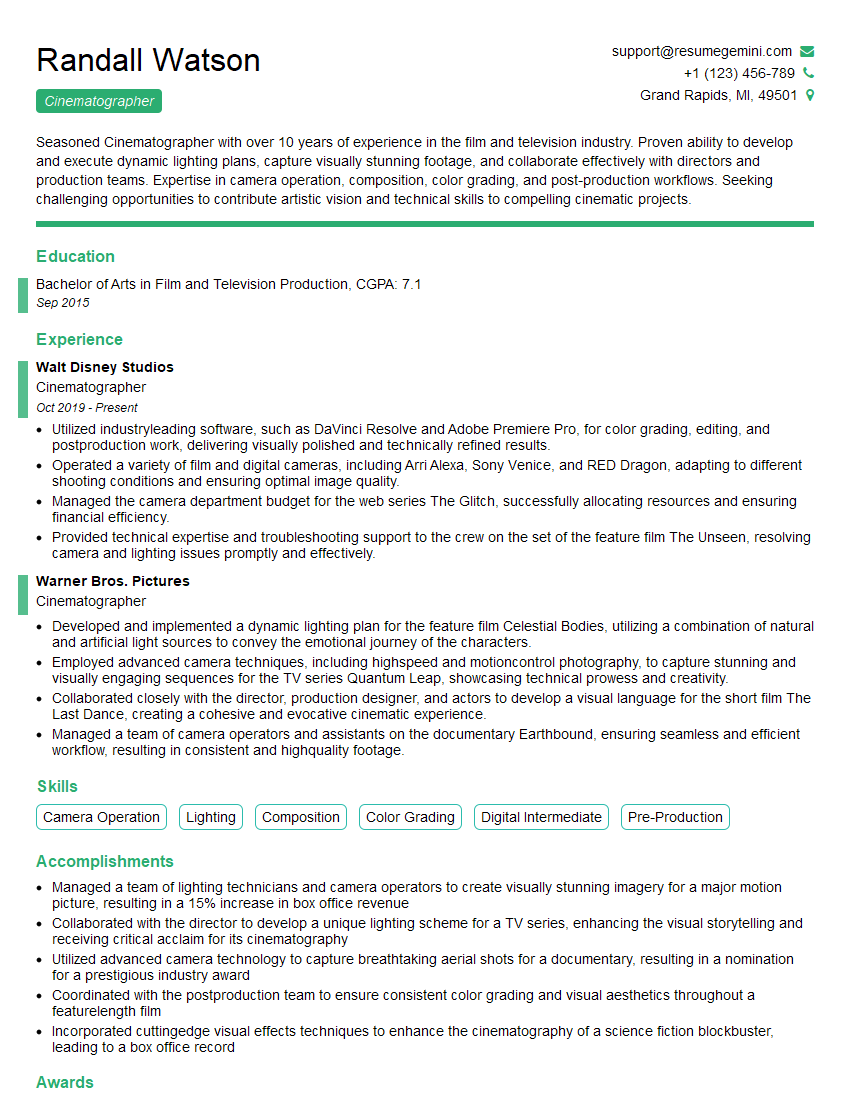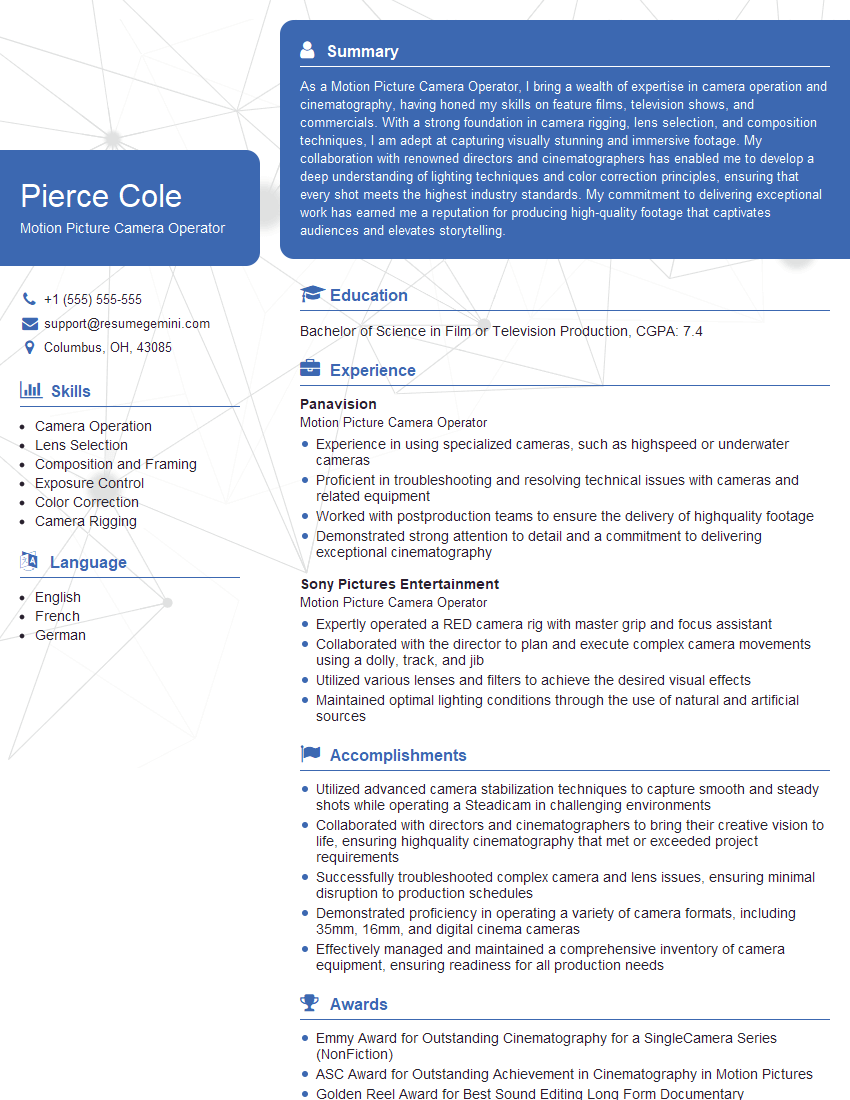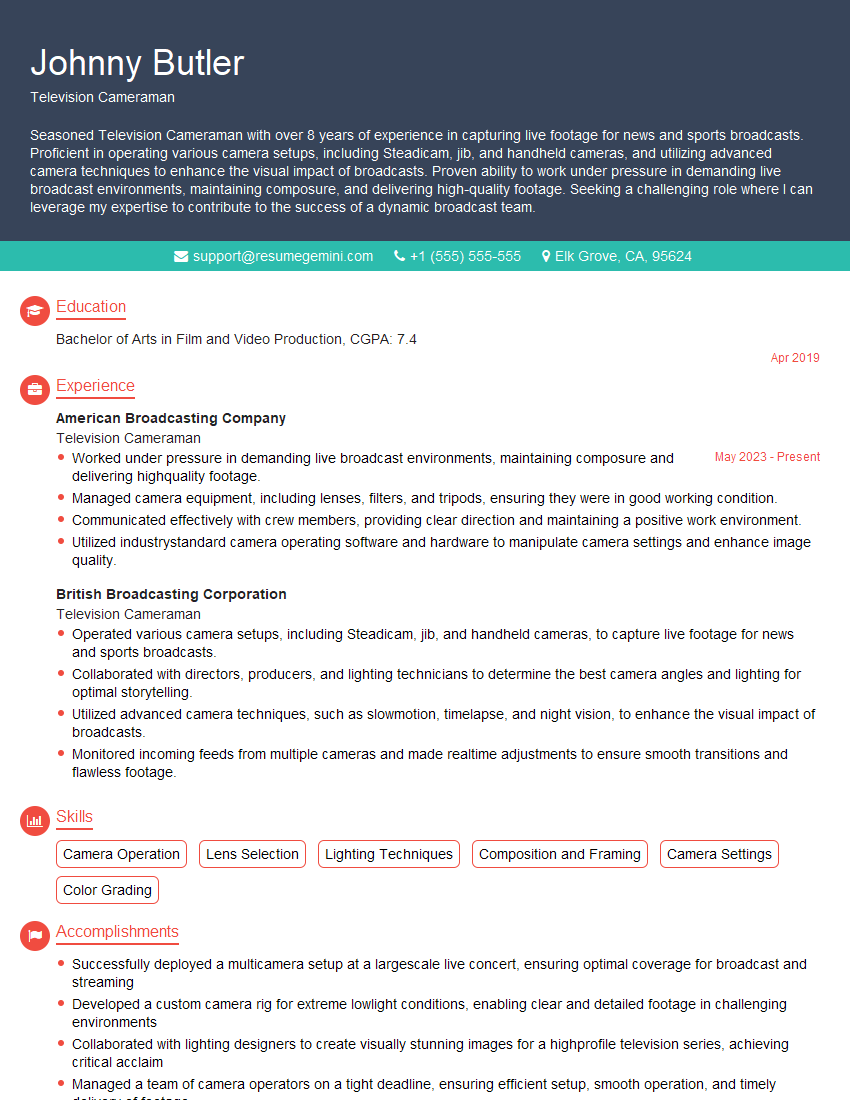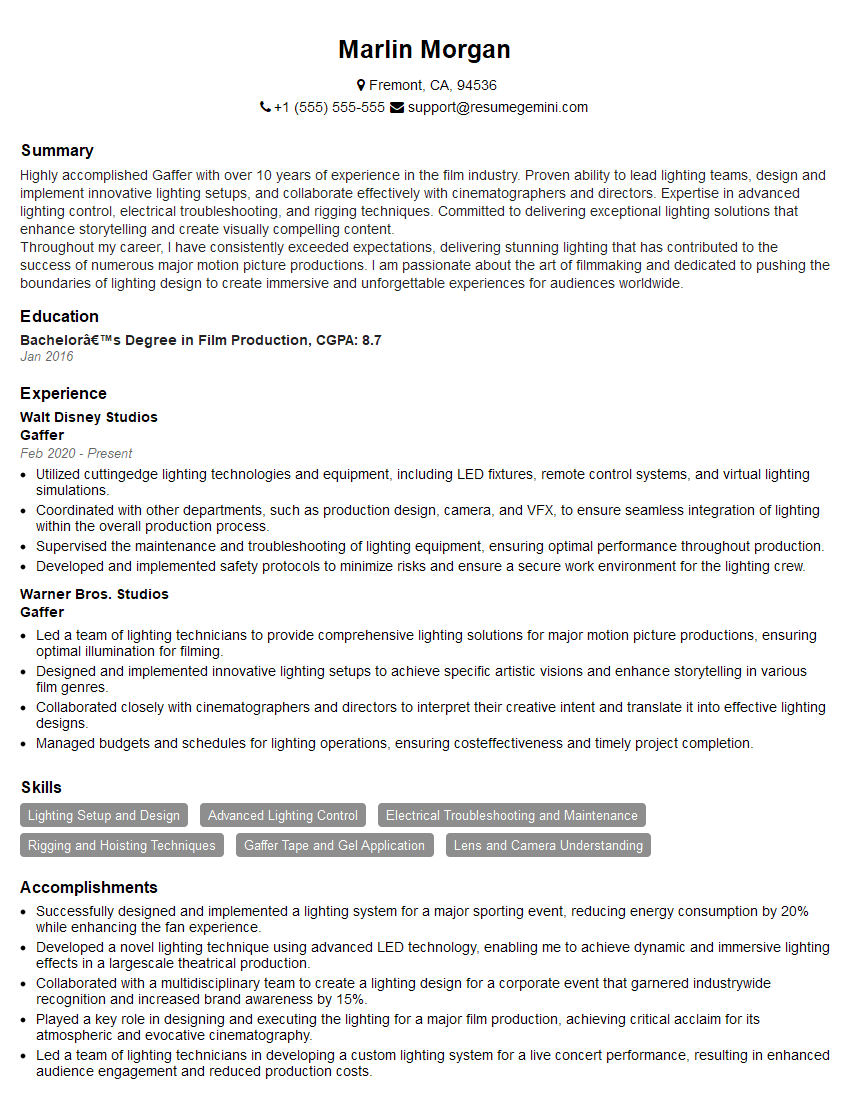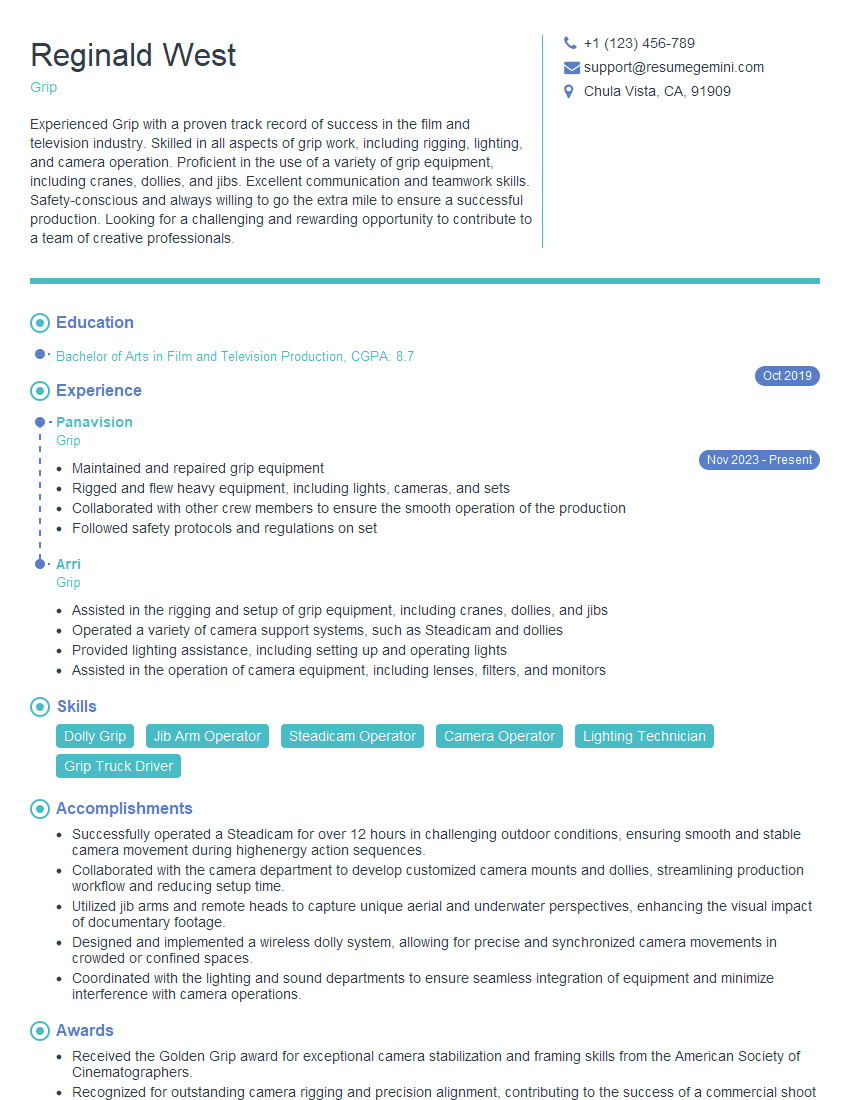Preparation is the key to success in any interview. In this post, we’ll explore crucial Dynamic Camera Movement interview questions and equip you with strategies to craft impactful answers. Whether you’re a beginner or a pro, these tips will elevate your preparation.
Questions Asked in Dynamic Camera Movement Interview
Q 1. Explain the difference between a pan and a tilt.
Pan and tilt are fundamental camera movements that control the camera’s orientation. A pan is a horizontal rotation of the camera, like sweeping your gaze across a landscape. Think of it as moving your head from left to right while keeping your eyes fixed straight ahead. A tilt, on the other hand, is a vertical rotation, moving the camera up or down. Imagine nodding your head; that’s a tilt. Both are often used in conjunction to create smooth, flowing shots.
For example, a pan might follow a character walking across a scene, while a tilt could emphasize the height of a building or the vastness of a sky.
Q 2. Describe the advantages and disadvantages of using a Steadicam.
The Steadicam is a revolutionary camera stabilization system that allows for incredibly smooth, fluid shots, even while moving. Advantages include its ability to create dynamic, flowing shots that feel intimate and immersive. It provides a sense of realism and presence that’s hard to achieve with other techniques. This is particularly useful for following characters through complex environments or during action sequences.
However, there are disadvantages. Steadicam operation requires highly skilled operators who undergo extensive training. The equipment itself is quite heavy and cumbersome, limiting its portability. Furthermore, shots often need careful planning and precise execution to avoid unwanted camera shake or motion.
For instance, in one project, we used a Steadicam to follow a character through a bustling marketplace. The smooth, flowing shots perfectly captured the energy and chaos of the environment while keeping the focus on our character.
Q 3. How do you plan camera movements to enhance storytelling?
Camera movements are crucial for storytelling. They enhance the narrative by guiding the viewer’s attention, emphasizing emotional beats, and revealing information gradually. Planning involves a careful consideration of the scene’s emotional tone, pacing, and the desired impact on the audience.
For example, a slow, deliberate pan across a character’s face can highlight their emotional turmoil, while a quick, jarring zoom might be used to convey surprise or shock. Long, tracking shots can create a sense of immersion, while quick cuts interspersed with dynamic movements can build suspense and excitement.
Before shooting, I create storyboards which detail each planned camera movement, precisely outlining the shot’s purpose and execution. This ensures that the movements enhance the narrative smoothly, not distract from it.
Q 4. What are some common safety precautions when using dynamic camera techniques?
Safety is paramount when using dynamic camera techniques. Several precautions are essential. Firstly, always ensure the area is clear of obstacles and potential hazards before executing complex movements like jib or crane shots. This prevents collisions and potential damage to equipment and injury to personnel.
Secondly, never operate heavy equipment without proper training and supervision. Proper weight balancing is crucial when using cranes or dollies to prevent tipping or accidental falls. Thirdly, always use appropriate safety harnesses and restraints when working at heights or with potentially unstable equipment. Lastly, always have a spotter present during dynamic camera movements to assist the operator and ensure safety.
Q 5. Explain your experience with different types of camera supports (e.g., jib, dolly, crane).
My experience encompasses various camera supports. I’ve extensively used jibs for dramatic overhead shots and sweeping movements, particularly useful in establishing shots or showcasing vast landscapes. Dollies provide smooth, controlled tracking shots, ideal for following characters or revealing details progressively. I have also worked with cranes for impressive high-angle shots, offering a unique perspective and scale. Each support offers unique creative capabilities, and the choice depends entirely on the specific needs of the shot.
One project required capturing a character walking through a dense forest. We used a dolly to smoothly track alongside them, creating a sense of intimacy and immersion. Another project utilized a crane to capture a breathtaking aerial view of a city skyline, establishing the setting with grandeur.
Q 6. How do you ensure smooth and fluid camera movements?
Smooth and fluid camera movements are achieved through a combination of factors. Proper equipment maintenance is crucial – ensuring that all moving parts are lubricated and functioning correctly. Skilled camera operation is paramount; operators need to be trained to execute smooth movements, avoiding sudden jerks or unwanted vibrations. Careful planning and rehearsal are essential to ensure the shots flow seamlessly. Finally, post-production techniques such as digital stabilization can further enhance fluidity and compensate for minor imperfections.
Q 7. Describe your experience working with various camera rigs.
My experience spans various camera rigs, including Steadicams, gimbals, and specialized rigs for underwater or extreme environments. Gimbals, for instance, offer exceptional stabilization for handheld shots, enhancing fluidity while allowing for greater mobility than a Steadicam. Specialized rigs allow shooting in challenging locations or situations, ensuring safe and effective capture of unique perspectives. Each rig’s selection depends on the demands of the production and the desired aesthetic.
For a recent documentary, we employed a specialized underwater rig to capture footage of marine life. The rig’s stability and waterproof casing ensured that the footage was clear and smooth despite the challenging environment.
Q 8. How do you coordinate camera movements with other elements of filmmaking (e.g., lighting, sound)?
Coordinating camera movement with lighting and sound is crucial for a cohesive and impactful scene. It’s not just about the camera moving; it’s about the entire scene’s rhythm and emotional impact. Think of it like a dance – the camera, lighting, and sound are all partners, each contributing to the overall choreography.
For example, a slow dolly shot into a character’s face might be accompanied by a gradual crescendo in the music and a softening of the lighting to emphasize vulnerability. Conversely, a fast whip pan during a chase scene would likely use harsher lighting and a dynamic, percussive soundscape.
- Lighting: The camera’s movement often dictates where the key light needs to be placed to maintain consistent exposure and avoid harsh shadows. A moving camera needs a lighting plan that anticipates its path.
- Sound: Sound design should complement the camera’s energy. A smooth, graceful camera movement might call for subtle ambient sounds, while a jarring, erratic movement demands a more powerful soundscape.
- Practical Example: On a recent project featuring a tense dialogue scene, we used a slow, deliberate zoom towards the actors as their emotional intensity grew. This was matched by a subtle increase in the background music and a gradual dimming of the surrounding room light to create intimacy and highlight their emotional states.
Q 9. Explain your understanding of shot composition and its relationship to dynamic camera movement.
Shot composition is the foundation upon which dynamic camera movement builds. It’s about how the elements within the frame are arranged – the subject’s position, leading lines, and the overall balance of the image. Dynamic camera movement needs a strong compositional base; otherwise, the movement feels aimless or disorienting.
For instance, the ‘rule of thirds’ remains important, even during movement. A character walking towards the camera, following a leading line towards the top third of the frame, creates a sense of purposeful movement and narrative drive. Conversely, using the rule of thirds effectively during a tracking shot guides the viewer’s eye through the scene naturally.
The relationship lies in the fact that the composition should anticipate and complement the camera’s movement. The movement should enhance the composition rather than disrupt it. A poorly planned shot can lead to an awkward framing or make the movement feel unnatural, no matter how technically proficient it is.
Q 10. How do you adapt your camera techniques to different shooting environments?
Adapting camera techniques to different environments requires flexibility and problem-solving. A smooth Steadicam shot in a wide-open field is vastly different from maneuvering a jib in a cramped interior.
- Indoor vs. Outdoor: Outdoor shoots might involve dealing with unpredictable weather, while indoor shoots may present challenges related to space limitations and lighting control.
- Space Constraints: In tight spaces, smaller cameras and camera rigs (like gimbals) become essential. You need to carefully plan the path of the camera to avoid collisions.
- Lighting Conditions: Varying light levels require adjustments to camera settings (ISO, shutter speed, aperture) and perhaps the use of supplementary lighting equipment.
- Terrain: Rough terrain can limit your choices to tracks, dollies or even handheld shots. A dolly might be impossible on uneven ground.
For example, on a recent documentary shoot in a bustling marketplace, I used a handheld gimbal to navigate the crowds smoothly while maintaining a clear focus on the subject. This was preferable to a bulky Steadicam due to the confined space.
Q 11. Describe your experience with remote camera operation (e.g., drones).
My experience with remote camera operation, primarily using drones, has significantly broadened my toolkit for dynamic camera movements. Drones allow for shots that were previously impossible or incredibly expensive to achieve. This includes sweeping aerial shots, following action from unique perspectives and achieving dynamic movement that would have been very difficult otherwise.
However, operating a drone requires a different set of skills. Beyond the technical aspects of flying the drone safely and smoothly, understanding wind conditions, battery life, and legal restrictions is critical. Careful planning of flight paths and shots are essential to avoid accidents and ensure the highest quality footage. I always prioritize safety – both for the equipment and the environment.
One memorable project involved using a drone to capture a breathtaking sequence of a lone hiker traversing a rugged mountain range. The drone’s ability to follow the hiker at a safe distance provided stunning visuals that would have been impossible to capture otherwise.
Q 12. What are some creative ways to use dynamic camera movements to create visual interest?
Dynamic camera movements are not just about functionality; they’re about creating visual interest and enhancing storytelling. Here are a few creative ways to achieve this:
- Creative Dolly Zoom (Vertigo Effect): This classic technique uses simultaneous zooming and dollying in opposite directions to create a disorienting, surreal effect, often used to portray emotional turmoil or a shifting perspective.
- Whip Pans: Fast, abrupt pans can be used to create a sense of urgency, disorientation, or to transition between scenes. They need to be carefully executed to avoid nausea.
- Dutch Angles (Canted Angles): Tilting the camera to create an off-kilter perspective can be used to portray unease, disorientation, or a chaotic atmosphere.
- Point-of-View (POV) Shots: Using a dynamic camera movement to simulate a character’s perspective can immerse the viewer in their experience.
- Drone Shots: Aerial shots offer unique and visually striking perspectives. These can be used for establishing shots, showcasing grandeur, or emphasizing the scale of a scene.
For example, a recent project involved using a combination of a dolly zoom and a slow, circular pan around a central character to illustrate their isolation and growing paranoia.
Q 13. How do you troubleshoot technical issues during dynamic camera shots?
Troubleshooting during dynamic camera shots requires a proactive and systematic approach. It’s about anticipating potential problems and having solutions ready.
- Equipment Malfunctions: If a motor fails on a dolly or gimbal, the backup plan is crucial. This could involve switching to a handheld shot or using a different piece of equipment. Always have a backup plan!
- Unexpected Obstructions: An unforeseen object in the path of a tracking shot requires immediate adaptation. This may involve rerouting the shot or adjusting the framing.
- Lighting Issues: Sudden changes in light levels need immediate adjustments to the camera settings or supplementary lighting. Keeping spare batteries and lights is critical.
- Focus Issues: Keeping focus sharp during complex movements requires a skilled focus puller, but even then, manual adjustments may be needed. Practice using focus assists.
My strategy emphasizes thorough pre-production planning, which helps minimize on-set issues. Rigorous testing of equipment and a communication-rich set environment are essential to quickly identifying and resolving any issues that arise.
Q 14. Explain your workflow for planning and executing complex camera movements.
My workflow for planning and executing complex camera movements involves several key stages:
- Pre-Production: This stage includes reviewing the script, storyboarding the shots, creating detailed camera movement plans and pre-visualization using software like Storyboard Pro, or even simply drawing it out.
- Rehearsals: Before the actual shoot, it’s crucial to conduct rehearsals with actors and crew to work out the timing and coordination of the camera movement with the action. This also helps identify potential problems.
- Tech Rehearsal: A technical rehearsal involves setting up all equipment and testing the entire sequence to make sure everything functions smoothly.
- Shot Execution: During the actual shoot, clear communication between the camera operator, focus puller, and director is key. The operator ensures precise execution of the planned movement while the focus puller maintains sharp focus.
- Post-Production: Even after the shoot, some adjustments might be needed during post-production, such as using stabilization techniques to correct for minor inconsistencies.
A recent project involved a complex Steadicam shot through a crowded marketplace, requiring careful pre-planning and choreography to avoid collisions. Through meticulous storyboarding, rehearsals, and clear communication, we successfully executed this complex shot, creating a dynamic and engaging scene.
Q 15. Describe your experience using camera movement to emphasize emotional impact in a scene.
Camera movement is a powerful tool for amplifying emotional resonance in a scene. By carefully choreographing the camera’s path, we can subtly or dramatically influence the viewer’s emotional response. For instance, a slow, deliberate tracking shot following a character experiencing grief can heighten the sense of sadness and isolation. Conversely, a fast, chaotic handheld shot during a tense action sequence can immerse the viewer in the character’s anxiety and fear.
In one project, we were filming a scene where a character receives devastating news. Instead of a static shot, we used a slow zoom into the character’s face as they processed the information, allowing the audience to share their emotional journey intimately. The gradual tightening of the frame mirrored the character’s internal constriction, creating a powerful sense of vulnerability and heartbreak. Another example involved a scene of joyful reunion; a circling, dynamic shot emphasized the energy and excitement of the moment, creating a sense of celebratory chaos.
Understanding the emotional subtext of the scene and choosing camera movements that resonate with it is key. This requires a strong collaboration with the director, understanding their vision and translating it into compelling cinematic language through camera movement.
Career Expert Tips:
- Ace those interviews! Prepare effectively by reviewing the Top 50 Most Common Interview Questions on ResumeGemini.
- Navigate your job search with confidence! Explore a wide range of Career Tips on ResumeGemini. Learn about common challenges and recommendations to overcome them.
- Craft the perfect resume! Master the Art of Resume Writing with ResumeGemini’s guide. Showcase your unique qualifications and achievements effectively.
- Don’t miss out on holiday savings! Build your dream resume with ResumeGemini’s ATS optimized templates.
Q 16. What are some common mistakes to avoid when using dynamic camera movements?
Many pitfalls can sabotage even the most meticulously planned dynamic camera movements. One common mistake is excessive movement. Overuse can distract from the narrative, making the viewer feel nauseous or overwhelmed instead of engaged. Another is poorly motivated movement; the camera should move for a specific reason – to follow a character, reveal something hidden, or create a particular emotional effect. Unmotivated or jarring movements are jarring and detract from the scene.
- Jumpy or jerky movements: Smooth, controlled movements are generally preferred, unless the scene requires a specific stylistic choice, such as handheld to convey chaos.
- Ignoring the 180-degree rule: Breaks in the 180-degree rule (which maintains consistent screen direction) can disorient the audience and break the illusion of reality.
- Over-reliance on gimbals or stabilizers: While these tools are beneficial, relying on them exclusively can lead to monotonous or predictable shots. Sometimes the imperfections of a handheld shot add character and dynamism.
Careful planning and thoughtful execution are crucial to avoid these common mistakes. Pre-visualization and rehearsal are essential to ensure the camera moves seamlessly and contribute positively to the scene’s emotional impact and narrative clarity.
Q 17. How do you work collaboratively with the director and other crew members to achieve the desired camera movements?
Collaboration is paramount in achieving successful dynamic camera movements. I start by engaging in detailed discussions with the director, understanding their artistic vision for the scene and the emotional impact they wish to convey. We’ll review the script, storyboard, and any existing visual references to align our expectations.
Then, I work closely with the camera operator, first assistant camera (1st AC), and the Steadicam operator (if applicable). We’ll collaboratively plan the shot, discussing the specifics of the movement, speed, and any potential challenges. This involves technical discussions about camera settings, equipment choices, and safety procedures. The 1st AC plays a crucial role in ensuring the smooth operation of the camera, while the Steadicam operator (if used) adds their expertise in fluid and controlled movements.
I frequently use storyboards and animatics to visualize the planned movements, ensuring everyone is on the same page. On set, constant communication is key, allowing for adjustments and improvisations as needed to accommodate unforeseen circumstances. A unified team effort is crucial for executing complex dynamic camera shots successfully and safely.
Q 18. Explain your experience with different camera movement software or planning tools.
I have extensive experience with various camera movement planning tools, including industry-standard software like Shot Designer and Camera Planner. These tools allow me to pre-visualize camera movements, plan shot composition, and create detailed camera maps. They are invaluable in complex projects, as they help me communicate shot details clearly to the team and anticipate potential challenges before shooting.
Beyond software, I utilize storyboarding extensively. Though not software itself, storyboarding provides a visual roadmap, ensuring everyone involved understands the intended camera movement. I also find it effective to create simple annotated sketches and diagrams in addition to software outputs to help translate the concept even further.
My experience extends beyond digital tools to include traditional methods. I find that physically scouting locations and rehearsing movements in advance greatly enhances the quality and efficiency of the filming process. A combination of advanced software and traditional techniques provides a robust and versatile approach to planning dynamic camera movement.
Q 19. How do you ensure the safety of the camera and crew during dynamic camera movements?
Safety is my paramount concern when executing dynamic camera movements. This involves a multi-faceted approach, beginning with meticulous planning and risk assessment. We identify potential hazards beforehand, such as obstacles, uneven terrain, or proximity to actors or other crew members. Safety briefings are conducted with the entire camera crew before each shot, ensuring everyone understands their responsibilities and potential risks.
We use appropriate safety equipment, including harnesses, spotters, and safety nets, whenever necessary. The camera operator and Steadicam operator are trained professionals, experienced in handling equipment safely during dynamic movements. During filming, clear communication and constant situational awareness are essential; a designated safety officer often oversees complex movements.
For instance, when planning a fast-paced Steadicam shot in a crowded location, we’d carefully map out the trajectory, clear the area of obstacles and potential hazards, and employ spotters to guide the operator and ensure a safe path. This proactive approach minimizes risk and ensures a safe working environment for everyone involved.
Q 20. Describe a time you had to adjust your camera plans on set due to unforeseen circumstances.
During the filming of a chase scene, we planned a long, fluid Steadicam shot through a narrow alleyway. However, upon arriving on set, we discovered unexpected road construction blocking part of the intended path. This forced us to quickly adapt our plan.
Rather than abandoning the shot entirely, we collaboratively re-evaluated the alley’s geometry and potential alternative routes. We adjusted the Steadicam path, opting for a slightly shorter, more intricate route that avoided the construction while still capturing the energy and dynamism of the chase. The camera operator adeptly handled the revised path, and we were able to retain the intended emotional impact of the scene.
This experience emphasized the importance of flexibility and adaptability on set. While meticulous planning is crucial, the ability to quickly and efficiently adjust plans based on unforeseen circumstances is equally essential for successful filmmaking.
Q 21. How do you manage the technical challenges of low-light shooting with dynamic camera movement?
Shooting dynamic camera movements in low-light conditions presents significant technical challenges. The lower light levels necessitate higher ISO settings, which can introduce increased noise and grain to the footage. Moreover, maintaining a stable image during dynamic movements can become more difficult with slower shutter speeds needed to compensate for low light.
To mitigate these issues, I rely on several strategies. Firstly, we utilize high-quality low-light cameras with excellent sensor performance, minimizing the noise introduced at higher ISO settings. Secondly, we employ efficient lighting techniques, incorporating available light sources and strategically placed supplemental lighting to enhance the overall brightness of the scene without over-illuminating or causing harsh shadows.
Furthermore, utilizing image stabilization technology, such as gimbals and advanced in-camera image stabilization, is critical for achieving smooth, fluid movements even in challenging lighting conditions. Finally, post-production techniques such as noise reduction can help refine the footage and minimize the impact of grain and noise. A combination of careful planning, appropriate equipment, and skillful post-production processing are key to overcome the technical hurdles of dynamic camera movements in low-light conditions.
Q 22. How do you plan camera movements to accommodate the actors’ performances?
Planning camera movements around actors’ performances is crucial for capturing compelling visuals. It’s not just about following the actors; it’s about enhancing their performance through strategic camera choices. I start by carefully studying the script and the director’s vision. Then, during rehearsals, I observe the actors’ blocking (their movement on set) to identify key moments and emotional shifts. This informs my decisions about camera angles, distance, and movement. For example, a close-up might intensify an emotional moment, while a wider shot reveals the actor’s relationship to their environment. I also consider the rhythm of the scene. Quick, dynamic movements might match a fast-paced conversation, while slower, more deliberate movements can highlight a contemplative moment. I always keep open communication with the director and actors, ensuring that we’re all on the same page. I may even experiment with different camera setups during rehearsals to find what works best.
For instance, in a scene showcasing a character’s internal conflict, I might use a slow dolly push to emphasize their vulnerability as they navigate a difficult decision. Conversely, a quick pan might reflect the character’s rapid, erratic thinking during a tense situation.
Q 23. Describe your understanding of different camera movement speeds and their impact on the viewer.
Camera movement speed profoundly impacts the viewer’s experience, influencing mood, pacing, and emotional response. Slow movements, such as a gentle dolly push, can create a sense of calm, allowing viewers to fully absorb the details of a scene. Think of a slow pan across a breathtaking landscape – it invites contemplation and appreciation. Conversely, fast movements, like a whip pan or a rapid zoom, can inject energy, excitement, or even disorientation. A whip pan, for example, might be used to create a jarring transition between two scenes or emphasize the speed and chaos of a chase sequence. The speed of the movement also needs to align with the editing; a very fast camera movement followed by a slow cut might create a jarring effect.
Medium speeds provide a balance, conveying information without being overly intrusive. For example, a moderate-speed tracking shot might follow a character as they walk through a crowd, providing context and engagement without overwhelming the viewer. Choosing the right speed requires careful consideration of the scene’s content and the desired emotional impact.
Q 24. How do you utilize dynamic camera movements to create a sense of scale and space?
Dynamic camera movements are powerful tools for manipulating the viewer’s perception of scale and space. A low-angle shot, coupled with a slow zoom or a dolly move, can make a character or object appear more imposing. Conversely, high-angle shots, often combined with a wide lens, can diminish the subject and emphasize the vastness of their surroundings. This effect is further amplified by movement. A long, tracking shot moving through a vast landscape can emphasize the character’s isolation within a larger world. A series of close-ups followed by wide shots can highlight both the intimacy of a relationship and its location within a broader context.
For example, a scene set in a crowded marketplace could utilize a fast, chaotic dolly move through the crowd to emphasize the sensory overload, while a slow crane shot rising above a lonely figure could emphasize their isolation and vulnerability.
Q 25. How do you maintain consistency in camera movement across multiple takes?
Maintaining consistency in camera movement across multiple takes requires meticulous planning and execution. Precise marking on the ground for dolly tracks, careful pre-visualization of camera paths, and the use of specialized equipment like camera rigs and sliders all contribute to achieving this consistency. I frequently use storyboards and shot lists to visualize the camera movements before shooting, and I work closely with the camera operator and focus puller to ensure everyone understands the desired movement precisely. During filming, I usually use the same camera operator for a sequence to ensure a consistent style. We will often mark our starting and ending positions on the ground with tape. This, combined with a well-defined shot list, helps maintain consistency in the spatial relationship of the camera to the scene across different takes.
We also employ techniques like rehearsal and pre-planning to ensure the smoothness and consistency of our movements. If the camera is meant to follow an actor across a room, we will rehearse the movement multiple times before shooting.
Q 26. What are some resources you use to stay updated on new trends in dynamic camera movements?
Staying current on trends in dynamic camera movements involves a multifaceted approach. I regularly attend industry events, workshops, and film festivals, both physical and virtual, to see cutting-edge cinematography and learn from fellow professionals. I also follow key cinematographers and directors on social media and actively participate in online cinematography communities where discussions and sharing of techniques happen frequently. I find that analyzing films with innovative camera work—both critically and technically—is invaluable. Finally, studying the work of master cinematographers and reading books and articles on filmmaking techniques provides ongoing professional development.
For instance, I frequently review the work of Roger Deakins, Emmanuel Lubezki, and Hoyte van Hoytema and immerse myself in analyzing the techniques used in their films.
Q 27. Explain your experience using dynamic camera movements in different genres of filmmaking.
My experience with dynamic camera movements spans several genres. In action films, I’ve employed rapid, dynamic movements like whip pans and fast zooms to create a sense of urgency and excitement during chase scenes and fight sequences. In dramas, I’ve used slower, more deliberate movements to underscore emotional weight and intimacy in character-driven scenes. For instance, a slow, tracking shot following a character as they walk through a desolate landscape might emphasize their sense of isolation and despair. In comedies, the focus is often on using dynamic camera movements to create a sense of energy and visual humor, while in horror, it can be used to build tension and disorient the viewer.
In documentaries, dynamic camera movements can help create a sense of immediacy and involvement, pulling the viewer directly into the scene. This could be achieved with handheld camera work that moves with the subject and incorporates the environment naturally.
Q 28. Describe your experience with time-lapse or slow-motion techniques in relation to dynamic camera movements.
Time-lapse and slow-motion techniques offer unique opportunities to enhance dynamic camera movements. Time-lapse allows for capturing dramatic changes over extended periods. Coupling this with a slow, deliberate camera pan can create a visually stunning effect, compressing time and highlighting transformations. Imagine a time-lapse of a city skyline at night, slowly panning across the city as the lights turn on. Conversely, slow motion extends moments, magnifying the impact of dynamic movements. A slow-motion shot of a character falling, combined with a smooth tracking shot or a subtle zoom, can heighten the drama and the emotional intensity of the moment.
The combination of these techniques requires careful planning and execution and can significantly enhance the storytelling capabilities of the filmmaker. For example, a slow-motion shot of a dancer leaping across a stage, combined with a dynamic tracking shot that follows them closely, could create a stunning visual sequence that showcases both their athleticism and the graceful fluidity of their movements.
Key Topics to Learn for Dynamic Camera Movement Interview
- Camera Movement Fundamentals: Understanding pan, tilt, zoom, dolly, truck, arc, and crane shots; their purpose and effect on storytelling.
- Composition and Framing: Applying the rule of thirds, leading lines, and other compositional techniques within dynamic camera movements to create visually engaging shots.
- Camera Movement and Storytelling: How different camera movements can enhance pacing, reveal information, build tension, and establish character relationships.
- Practical Applications: Analyzing examples of dynamic camera movement in film and television; identifying effective and ineffective uses.
- Shot Sequencing and Continuity: Mastering techniques to ensure smooth transitions between shots involving dynamic camera movements and maintaining visual coherence.
- Technical Aspects: Understanding camera support systems (e.g., dollies, jibs, Steadicam), their limitations, and best practices for their use.
- Problem-Solving: Troubleshooting common challenges related to camera movement, such as shaky footage, inaccurate framing, and maintaining continuity.
- Genre Considerations: How dynamic camera movement differs across various genres (e.g., action, drama, documentary).
- Safety Procedures: Understanding and adhering to safety protocols when operating cameras and employing dynamic camera techniques.
Next Steps
Mastering dynamic camera movement significantly enhances your storytelling abilities and opens doors to exciting opportunities in film, television, and beyond. A strong understanding of these techniques is highly valued by employers. To maximize your job prospects, focus on creating an ATS-friendly resume that effectively showcases your skills and experience. ResumeGemini is a trusted resource for building professional resumes that get noticed. We provide examples of resumes tailored to Dynamic Camera Movement to help you get started. Invest time in crafting a compelling resume—it’s your first impression with potential employers.
Explore more articles
Users Rating of Our Blogs
Share Your Experience
We value your feedback! Please rate our content and share your thoughts (optional).
What Readers Say About Our Blog
Interesting Article, I liked the depth of knowledge you’ve shared.
Helpful, thanks for sharing.
Hi, I represent a social media marketing agency and liked your blog
Hi, I represent an SEO company that specialises in getting you AI citations and higher rankings on Google. I’d like to offer you a 100% free SEO audit for your website. Would you be interested?
